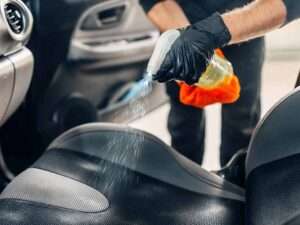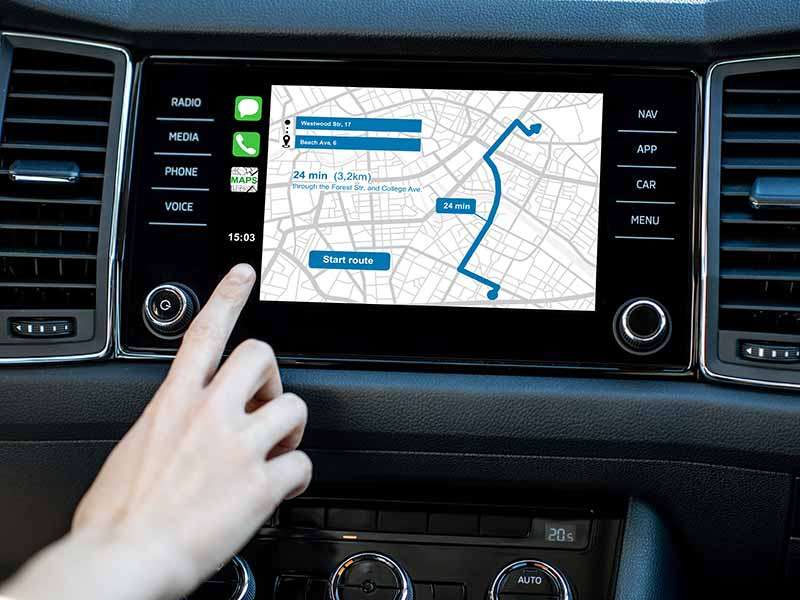Table of Contents
If you are like many people and have no shaded parking at you work or home, your car or truck gets absolutely baked in the sun. So, the question is how to protect your car from sun damage in open parking areas. Whether you’re driving a classic muscle car or a modern tire shredder, you want to keep your vehicle as pristine and safe from sun UV damage as possible.
When it comes to protecting the exterior, we all know to obviously keep it clean and coated with a good synthetic wax or ceramic coating for the best protection.
There are a few other tips for exterior protection that we’ll cover but the main issue cars have with sun damage is on the interior assuming they have a good paint sealant or ceramic coating applied to the paint.
Unless you own a garage queen, your car is going to be exposed to the sun for extended periods from time to time.
You may initially think of products such as a windshield sun shield, seat covers, dashboard cover, or even a car cover. None of these are ideal obviously. Who wants to have to fumble with a sun shield every time you get in or out of your car, cover up your gorgeous leather seats or dashboard with a less than appealing seat or dashboard cover, or have to deal with the hassle of a car cover often. Not this guy.
Let’s cover some great ways to help protect your interior from ultraviolet sun damage and touch on a few tips for the exterior.
Manufacturers Protection
It should be noted that the older your car the less protection it will have when it left the factory.
Newer vehicles will have more UV-blocking coatings applied to the glass, clear coat, and possibly other surfaces.
As the decades have marched forward, vehicle glass has advanced from no UV protection to very good UV protection today. It is also common for newer cars to have an urethane UV protective coating applied to leather surfaces. This coating also has other benefits to help extend the life of your leather such as reducing abrasion wear and helping the leather retain moisture to prevent premature cracking.
Even if you’re the owner of a brand new car, the factory UV protection isn’t perfect and varies from manufacturer to manufacturer.
Improving upon the factory protection is the smart option. If you have a convertible you have very little protection while the top is down so you’ll definitely want to do what you can to help improve your car’s interior protection.
Let’s dive into some effective alternatives to the less than appealing options, such as seat covers, that were previously mentioned.
UV Protectant Spray
The first option to consider is a proper dash protectant. Most dashboards are a synthetic material such as vinyl, plastic, or combination.
The best protectant to use is a quality protectant with good UV rejection. It works similar to how sunscreen works on your skin.
Aerospace 303 Protectant is regarded by many to be the absolute best vinyl and plastic protectant.
Unlike some other dashboard dressings, Aerospace 303 Protectant leaves a matte finish that isn’t sticky and won’t trap dust and dirt onto any surface it’s been applied onto.
You’ll want to thoroughly clean all surfaces that you apply Aerospace 303 Protectant onto so that it will adhere well.
It isn’t meant only to be applied to your dash. It can also be applied to any other vinyl or plastic interior pieces to protect them as well.
It will need to be reapplied from time to time but it is obviously much preferable to something like a seat cover.
When it comes to leather it may surprising to learn that Aerospace 303 Protectant is also the best leather UV protectant used by enthusiasts and detailers.
This product is water-based and is excellent for almost any type of surface. It allows the leather to breathe and remain properly hydrated, remaining supple.
You will also need to clean the leather thoroughly before coating with UV protectant.
Leather is often used not just on seats but on many surfaces that get handled frequently. Shift knobs, steering wheels, door handles, emergency brake levers, and the like are often wrapped in leather.
Leather is a great choice for all of these because it is so durable. But because it is used on these frequently handled objects it gets very dirty quickly.
Body oils rub off and attract dirt which gets ground in. A good leather cleaner will gently clean the leather and prepare it for moisturization.
You’ll need to apply a proper moisturizer to your leather once it has been cleaned but prior to applying the UV protectant.
There are plenty of great leather cleaners and moisturizers on the market and most well established brands work very well.
When cleaning your leather it’s smart to use a purpose-designed leather cleaning brush that will help pull the body oils and dirt up and away from the leather without damaging the factory leather protective coating on newer cars, or causing unwanted abrasion to leather on older vehicles.
A microfiber towel is great for wiping and buffing but a brush is going to make the job of loosening oils and dirt easier and more effective.
Ceramic Window Film
The other excellent suggestion I have is my favorite. Some people tint their windows to cut down on heat and UV rays passing through the glass. This is a great option if you want to darken your windows, but I’m not a fan of that look personally – from the outside or the inside.
An awesome alternative to darkening your windows is to use a clear UV-rejecting film. The best performing UV-blocking tints are commonly referred to as ceramic tint.
Most manufacturers offer varying levels of light transmission – dark to almost perfectly clear. To be as upfront about this as possible, you won’t be able to find a true UV-rejecting film that is 100% clear. All will block some visible light and therefore darken your windows slightly. The effect will be subtle and probably not noticeable unless doing a side-by-side comparison.
A huge tip when it comes to tinting to block UV and cut down on interior heat is to be sure to tint the windshield. For a long time it never occurred to me that this was an option.
Laws vary from state-to-state on the ability to do this. If you’re going with the clearest tint possible you should be able to tint the windshield completely in most states, although you may have to jump through some hoops to do so.
Contact your local tint shop and ask them about what’s involved and how to get this done. Also ask them about the best performing tints for heat and UV rejection.
It should be noted that tint shops usually don’t offer products from every tint manufacturer and will push only a handful of products from a couple of select manufacturers.
These may or may not be the best on the market. I’m not a window film expert but from what I understand most of the top performing window films perform similarly well.
You may want to do your research before settling on a single tint shop. You’ll want to research which tint performs best currently as well as which local shop has the most talented installers and warranties.
Some quality tint manufacturers that produce awesome UV-rejecting tint (In no specific order) are:
- 3M – Crystalline
- LLumar – Forumla One Pinnacle
- Prestige Films – Spectra Photosync
- Huper – Optik Ceramic
- Madico – Wincos
- SunTek – CarbonXP
These aren’t the only options but these are some of the most well respected products.
The less your car has UV-rejection built into the glass the more you’ll benefit obviously. Older vehicles will benefit the most but some modern cars don’t have as much UV-rejection designed into their glass as I’d like to see.
No matter the age of the vehicle you should see a good improvement in protection with the addition of a quality UV-blocking ceramic tint.
One last suggestion when it comes to window tinting is considering doing it yourself. MotoShield sells ceramic tint kits at a very reasonable price. If you have the desire to try it yourself you can save significantly.
Sun Shades
Personally, the idea of a traditional windshield sunshade doesn’t appeal to me. I’ve found them to be very cumbersome. If something is difficult to use I typically won’t end up using it regularly.
Windshield shades are very inexpensive and very effective though. Fortunately there are some companies that have come up with some clever solutions to make these shades easier to deal with.
One of these that I found and really like is the windshield umbrella. Essentially it’s a small umbrella that opens into a rectangle shape and fits in the same location as a traditional windshield shade. Pretty slick.
There are also roller shades for rear side windows and shades for your main rear window that are much easier to deal with or can be left up and covering the windows so you don’t have to frequently bother with them.
If sun is a serious issue for you then you might consider stepping up to the Lanmodo Automatic Car Umbrella. This umbrella can cover your entire vehicle and will protect not only the interior from UV rays but also the majority of the exterior.
It mounts to the top of your roof and can be secured with straps to side mirrors and door handles.
Your interior will be significantly cooler and your entire car – interior and exterior – will be kept at a much cooler temperature.
It’s surprisingly easy to use considering the massive amount of coverage it provides. It uses a suction cup to affix it to the roof of your car or truck and it has a remote that will automatically extend it. The securing straps are easy to attach. The entire process only takes seconds.
Helpful Links
Conclusion
The Lanmodo car umbrella is probably the most effective yet still reasonably convenient car protection from sun damage, inside and out. It doesn’t take much to place on top of your car or truck and is motorized so it can deploy and retract on its own.
Aside from covering things up either with a car umbrella or sunshades inside your vehicle, the best option is to filter out ultraviolet rays that are the source of damage to your car’s interior.
This is best done by applying UV blockers directly to surfaces inside your vehicle as well as to the glass. The more you filter out harmful UV rays the less damage your interior will suffer.
Using a good UV protectant like Aerospace 303 protectant is inexpensive and very effective.
Ceramic tinting is also excellent although far from inexpensive when having it professionally installed. Doing both will obviously get you the best results.
If having your windows tinted by a professional is a bit out of your budget you may want to consider the MotoShield ceramic tint kit. Most of the expense of window tint is in the labor. If you think you’re up to the challenge you can save quite a bit of money.










